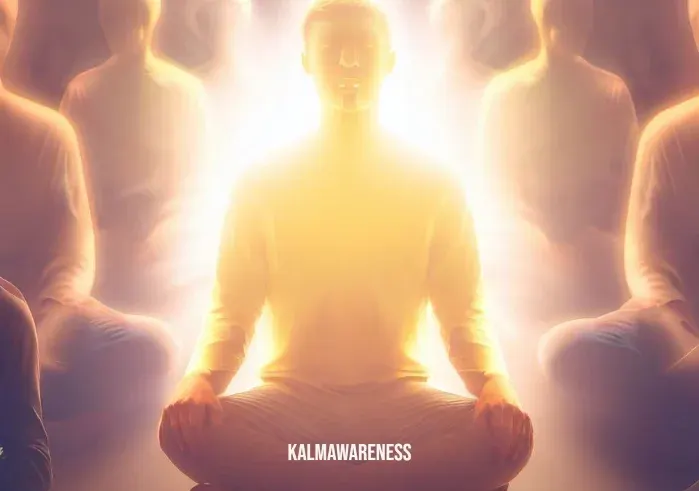How Mindful Meditation Encourages Practitioners to Harness Inner Peace and Balance
In the frenzied whirl of modern life, it’s easy to lose sight of one’s inner self. The constant pressures, endless tasks, and pervasive anxiety can distract us from the peace that lies within. However, a transformative technique offers a path to regain balance and serenity: mindful meditation. Practicing mindful meditation encourages practitioners to tap into their own mental clarity, emotional regulation, self-awareness, and natural mindfulness techniques. As we embark on this journey, let’s explore how mindful meditation fosters inner tranquility and balance.
A New Path to Mental Clarity
Mindful meditation encourages practitioners to focus on their breath, allowing them to shift their attention away from the clutter of thoughts and focus on the present moment. The process of taking some time to clear the mind allows for mental clarity to emerge. By being present, we distance ourselves from past regrets and future worries, discovering a new path towards a calm and composed mind.
“Mindful meditation provides a chance to engage with your thoughts, learning to observe them without judgment. This can lead to a significant increase in mental clarity.”
With practice, individuals can learn to master their thoughts, not by suppressing them but by acknowledging them and letting them pass, similar to the teachings in the how-to master mindfulness article.
Emotional Regulation through Mindfulness
Our emotions are an essential part of our humanity, yet they can sometimes feel like a tumultuous sea. Mindful meditation can help calm these waters, assisting practitioners to regulate their emotions effectively. Instead of being swept away by strong emotions like stress or anxiety, individuals can learn to respond calmly, maintaining their composure even in challenging situations.
One effective tool for achieving this emotional balance is the technique of mindfulness intentions. By setting an intention to remain calm and collected, practitioners can cultivate an inner environment that is less prone to emotional fluctuations.
Cultivating Self-Awareness
Self-awareness is a critical component of mindful meditation. Practitioners are encouraged to observe their thoughts, emotions, and sensations without judgment. This can lead to a deeper understanding of oneself, resulting in a heightened state of self-awareness.
The internal attention generated through mindful meditation allows practitioners to become more aware of their internal states, providing insight into patterns of thought and feeling that might otherwise go unnoticed. This heightened awareness can lead to greater self-understanding and personal growth.
To delve deeper into this topic, you may find it helpful to check out the comprehensive guide on how to keep your composure, which further discusses how mindful meditation can enhance self-awareness and emotional control.
This exploration of mindful meditation is merely a starting point. We invite you to continue to the next part of the article, where we will delve into mindfulness techniques and how they contribute to stress reduction. We will also explore how mindful meditation can improve emotional resilience, and look into the effectiveness of guided meditation practices such as seven-minute mind meditation, 20-minute mindfulness meditation, and more.

Nurturing Stress Reduction and Resilience through Mindful Meditation
Continuing our journey into mindful meditation, this transformative practice offers powerful tools for stress reduction and fostering resilience. Mindful meditation encourages practitioners to cultivate a mindful awareness of their internal and external experiences, enabling them to navigate stressors more effectively and build emotional resilience.
Stress Reduction: From Chaos to Calm
The benefits of mindful meditation in stress reduction are remarkable. In an increasingly chaotic world, our minds can often feel like a storm of thoughts and emotions. Through the practice of meditation for anxiety, practitioners learn to navigate through this internal storm with grace and tranquility.
By centering attention on the breath or a specific mantra, mindful meditation encourages practitioners to ground themselves in the present moment. This focused attention helps in calming the limbic system, the part of our brain responsible for managing stress responses. The result is a notable reduction in stress levels, bringing about a sense of peace and tranquility.
Building Emotional Resilience
Emotional resilience refers to our ability to adapt to stressful situations or crises effectively. Mindful meditation encourages practitioners to develop this crucial skill by promoting a non-judgmental awareness of their thoughts and emotions. Regular practice of mindfulness techniques fosters emotional resilience, enabling practitioners to bounce back from adversities more quickly and efficiently.
Below, we explore three essential mindfulness techniques that contribute to building emotional resilience:
- Mindful Breathing: This practice involves focusing on the breath, observing its rhythm without judgment. A 15-minute guided meditation for anxiety can provide an excellent starting point for this technique.
- Body Scan: This technique promotes awareness of physical sensations in different parts of the body. It can be particularly helpful in recognizing and releasing tension, as detailed in the body scan worksheet.
- Mindful Observing: This practice encourages practitioners to observe their surroundings or internal experiences without attaching any judgment or interpretation, as elucidated in the article on mindful life practice.
The table below provides a comprehensive overview of these techniques, their practices, and associated benefits:
| Technique | Practice | Benefits |
|---|---|---|
| Mindful Breathing | Focus attention on the inhalation and exhalation. | Calms the mind, reduces anxiety, enhances focus. |
| Body Scan | Mentally scan your body from head to toe, noting any sensations. | Increases body awareness, releases tension, aids relaxation. |
| Mindful Observing | Pay non-judgmental attention to your surroundings or internal experiences. | Enhances present-moment awareness, improves emotional regulation. |
As we deepen our understanding and practice of mindful meditation, we’ll delve into the world of guided meditations. In the next part of our article, we will explore a variety of meditation practices, including the Emily Fletcher guided meditation and others that can help further enhance mindfulness and stress reduction. Stay tuned for insights into harnessing the power of guided meditations and unlocking the potential of mindfulness.

The Magic of Guided Meditations: Deepening Mindful Awareness
Diving deeper into our exploration of mindful meditation, the next focus of our journey is guided meditations. A remarkable tool for all practitioners, whether beginners or seasoned meditators, guided meditation provides structured practice that makes meditation more accessible. It’s here that mindful meditation encourages practitioners to surrender control, allowing the guide’s voice to lead them through the practice.
Guided Meditations: An Introduction
Guided meditations are meditative practices where a narrator or teacher provides clear instructions throughout the meditation. These instructions often involve visualizations, affirmations, or mindful awareness exercises. As Andrew Huberman, a renowned neuroscientist, rightly said, “Guided meditations provide the perfect bridge for those looking to step into the realm of mindfulness.”
Whether it’s a 7-minute mindfulness meditation, a longer 1-hour guided meditation, or a specific guided meditation for pain and anxiety, guided practices offer the advantage of structure and direction. This makes them an excellent choice for beginners who might struggle to concentrate or lack understanding about where to start.
The Benefits of Guided Meditations
By providing a structured approach to mindfulness, guided meditation helps practitioners tap into the calming, stress-reducing power of mindful meditation more effectively. Here are some key benefits:
- Ease of Practice: With a voice guiding you through each step, practitioners find it easier to focus on their meditation, as mentioned in the article 10-minute guided meditation for anxiety.
- Skill Development: Guided meditations can help practitioners learn and refine different meditation techniques. For instance, a body scan meditation for sleep can help improve body awareness and promote relaxation.
- Enhanced Focus: Following a guide’s voice can enhance concentration and make it easier to stay in the present moment. This ability to focus is a fundamental skill in mindfulness meditation.
- Emotional Regulation: As Thich Nhat Hanh famously stated, “Feelings come and go like clouds in a windy sky. Conscious breathing is my anchor.” Guided meditations, like the meditation for BPD, can assist in regulating emotions, fostering emotional resilience and stability.
In the words of Jon Kabat-Zinn, “Meditation is the only intentional, systematic human activity which at the bottom is about not trying to improve yourself or get anywhere else, but simply to realize where you already are.” This acceptance and presence are what mindful meditation encourages practitioners to foster.
As we move to the next part of our journey, we will delve into the advanced practices of mindful meditation. Expect a deep dive into mindfulness techniques that enhance self-awareness and emotional regulation, including the mindful behavioral solutions, and how to utilize tools like the mind mirror to improve your mindfulness practice. Stay tuned to expand your knowledge and enrich your mindful meditation journey.

Harnessing the Power of Mindful Techniques: A Journey into Self-Awareness
Now that we have journeyed through the realms of basic and guided meditation practices, it’s time to dive deeper. Our focus in this chapter shifts towards specific mindfulness techniques. These techniques are what mindful meditation encourages practitioners to master, building self-awareness and emotional regulation.
Mindful Behavioral Solutions: The Power to Change
Mindfulness, at its core, is about being present in the moment, without judgment. By fostering mindfulness, we enhance our ability to regulate our emotions and make wiser decisions about our behavior. According to this article, mindful behavioral solutions help practitioners to react less impulsively and instead, respond with wisdom and equanimity.
“Do not dwell in the past, do not dream of the future, concentrate the mind on the present moment.” – Buddha. These words embody the essence of mindfulness and encourage us to focus on the present, bringing about change from within.
Techniques for Building Self-Awareness
One of the core elements of mindfulness is self-awareness. By being aware of our thoughts, feelings, and actions, we gain a better understanding of ourselves, which aids in emotional regulation. The Mind Mirror is one tool that practitioners can utilize to build self-awareness.
- Body Scans: This practice involves paying attention to different parts of the body, from the tips of the toes to the top of the head. It helps you develop a stronger connection with your physical body. A worksheet can be found here.
- Mindful Breathing: This involves focusing on the breath – the inhalation and exhalation, the rhythm, the sensation. You can try this 20-minute mindfulness meditation.
- Observation: This technique involves observing the environment around you in detail, such as the sound of the breeze, the feel of the earth under your feet, or the smell of grass.
| Technique | Benefit | Recommended Practice |
|---|---|---|
| Body Scans | Increased body awareness | Body Scan Worksheet |
| Mindful Breathing | Calmness and focus | 20-minute mindfulness meditation |
| Observation | Improved focus and presence | Mindful walks in nature |
As Eckhart Tolle beautifully puts it, “Realize deeply that the present moment is all you have. Make the NOW the primary focus of your life.” Mindful meditation encourages practitioners to harness the power of the present, building emotional regulation and self-awareness.
In the upcoming chapter, we will venture into mindfulness meditation’s role in specific situations, such as dealing with intrusive thoughts and how we can use techniques like cognitive mediation to manage them. This segment will also shed light on concepts like alpha wave meditation, offering a deeper understanding of the brain’s role in meditation. Stay tuned for this enlightening continuation of our mindful meditation journey.

Navigating the Inner Terrain: Meditation for Complex Emotions
Our mindful meditation journey continues into deeper waters, addressing the ways in which mindfulness meditation encourages practitioners to handle complex emotions and thoughts. A plethora of mindful techniques are at our disposal to help us navigate the tumultuous inner terrain of stress, anxiety, and intrusive thoughts.
Intrusive Thoughts: Unwanted Guests in the Mind
Firstly, let’s examine the concept of intrusive thoughts. As the name implies, these are unwanted thoughts that suddenly invade our consciousness, causing distress or anxiety. Mindful meditation techniques can help us in managing these unwelcome mental visitors. According to an article on kalmawareness.com, even physical tools like crystals can support our mindful practice, aiding in grounding and focus during meditation.
Cognitive Mediation: The Mind’s Peacekeeper
Next, we delve into the realm of cognitive mediation. Cognitive mediation is a psychological concept explaining how our thoughts can influence our emotions and behavior. Mindful meditation encourages practitioners to employ cognitive mediation as a means to develop better control over their emotional responses, thereby improving emotional health and overall well-being.
Alpha Wave Meditation: Riding the Waves of Calm
Finally, let’s explore alpha wave meditation. This method utilizes sound frequencies, particularly alpha waves, to induce a state of calm and relaxation in the brain. Regular practitioners of alpha wave meditation report a significant reduction in stress and anxiety, providing yet another powerful tool in the arsenal of mindfulness meditation.
“Meditation is not evasion; it is a serene encounter with reality.” – Thích Nhất Hạnh
Mindful meditation encourages practitioners to face their inner realities and embrace all facets of their emotional landscape. It equips them with a set of powerful tools that foster self-awareness, emotional regulation, and mental clarity.
As we continue our journey into the depths of mindful meditation in the following chapter, we will touch on topics such as ADHD and the role of mindfulness in managing symptoms. We’ll learn more about useful tools like the ADHD mindfulness app, and explore mindfulness meditation’s impact on personality disorders such as BPD. The exploration of these specialized applications of mindfulness meditation promise to provide valuable insights for practitioners dealing with these specific challenges. Stay tuned for the next enlightening chapter of our mindful meditation exploration.

The Final Stretch: Lightening the Load with Mindful Meditation
As we journey toward the culmination of our exploration, it’s important to remember that mindful meditation encourages practitioners to approach life’s challenges with a sense of lightness. Far from being a tiresome struggle, mindfulness is a practice of gentle awareness, providing relief and balance in a world that often seems to demand more than we can give.
Overcoming the Crisis Mindset
Stress is often an unavoidable part of life. However, there’s a vast difference between manageable stress and a full-blown crisis. An article on kalmawareness.com distinguishes between a stressor and a crisis, highlighting the crucial role of mindful meditation in transforming our reactions to stressful situations. When we meditate, we teach our minds to step back from the brink of crisis, acknowledging stressors without allowing them to overwhelm us.
Resetting the Emotional Circuitry
Sometimes, emotional reactions can feel automatic, as if a hidden switch has been flipped within us. But what if we could learn to reset our affective circuits? Mindful meditation encourages practitioners to consciously reset their affective circuits – that is, the neural pathways that determine our emotional responses. By practicing mindfulness, we can reshape these pathways, learning to respond to life’s ups and downs with greater emotional equilibrium.
Unleashing the Power of Patience
Patience, often underappreciated, is a potent ally on the path to inner peace. A mindful life practice requires patience, as changes often occur gradually. A lovely piece on kalmawareness.com discusses the power of patience and its role in mindfulness, offering strategies to cultivate this virtue. Like a tree that takes years to grow, the fruits of patience are worth the wait.
“Patience is the calm acceptance that things can happen in a different order than the one you have in mind.” – David G. Allen
As we come to the close of our journey, let’s take a moment to appreciate the lightness and ease that mindful meditation brings to our lives. By approaching our inner landscape with gentleness, patience, and openness, we can truly learn to navigate life with grace and serenity.
Conclusion: The Journey Continues
The journey of mindful meditation, just like life itself, is ongoing. This article merely offers a glimpse into the transformative power of mindfulness, a practice capable of fostering self-awareness, emotional regulation, and mental clarity. The more we practice, the more we discover, for every moment of mindfulness shines a light on our intrinsic potential for peace, joy, and wisdom.
As we continue to explore the world of mindfulness, kalmawareness.com invites you to delve deeper, harness the power of mindfulness, and uncover your true potential. Remember, the mindful journey doesn’t end here. Let us continue to explore, learn, and grow together.
May you find peace and clarity on your mindful journey.




